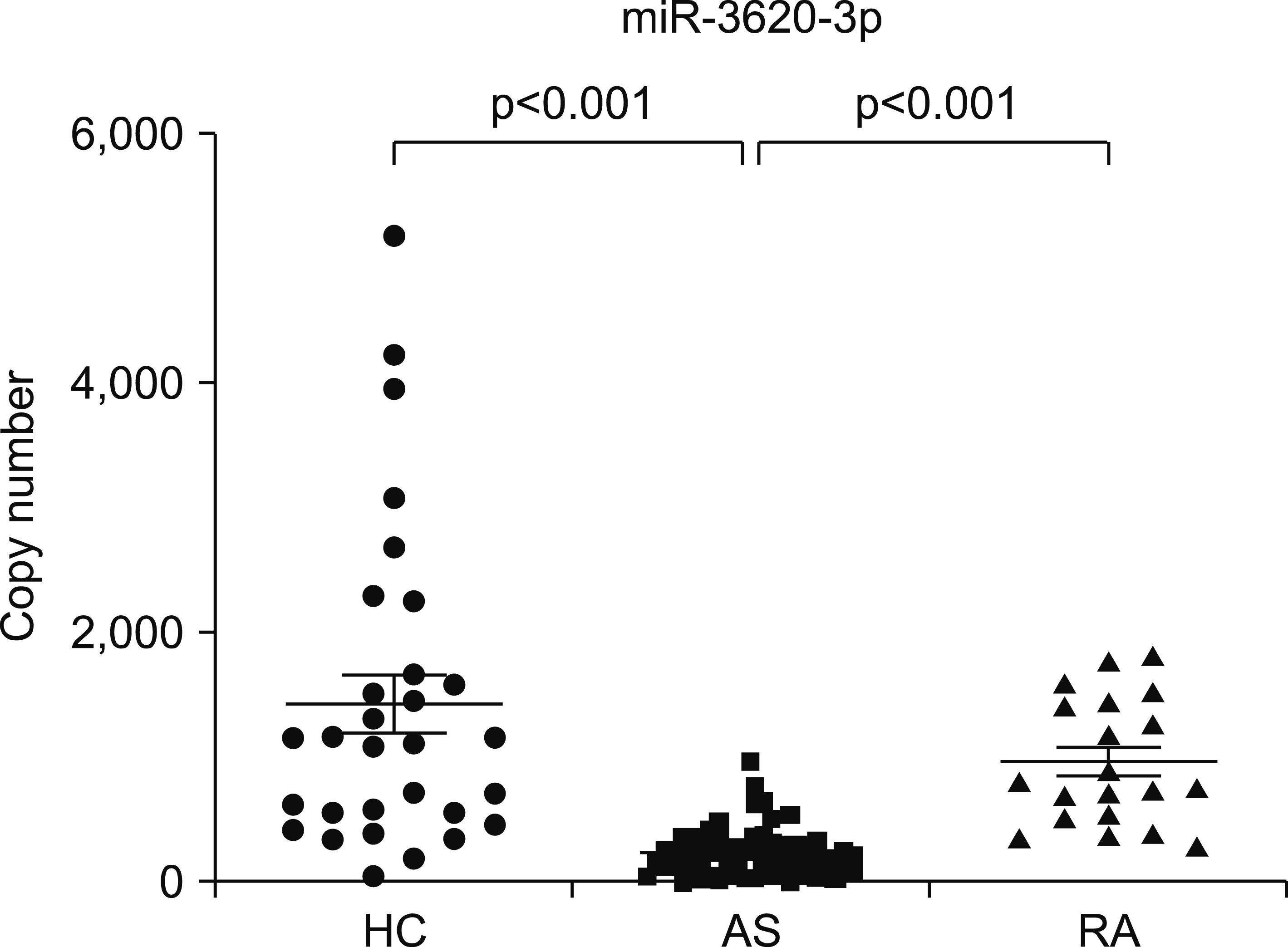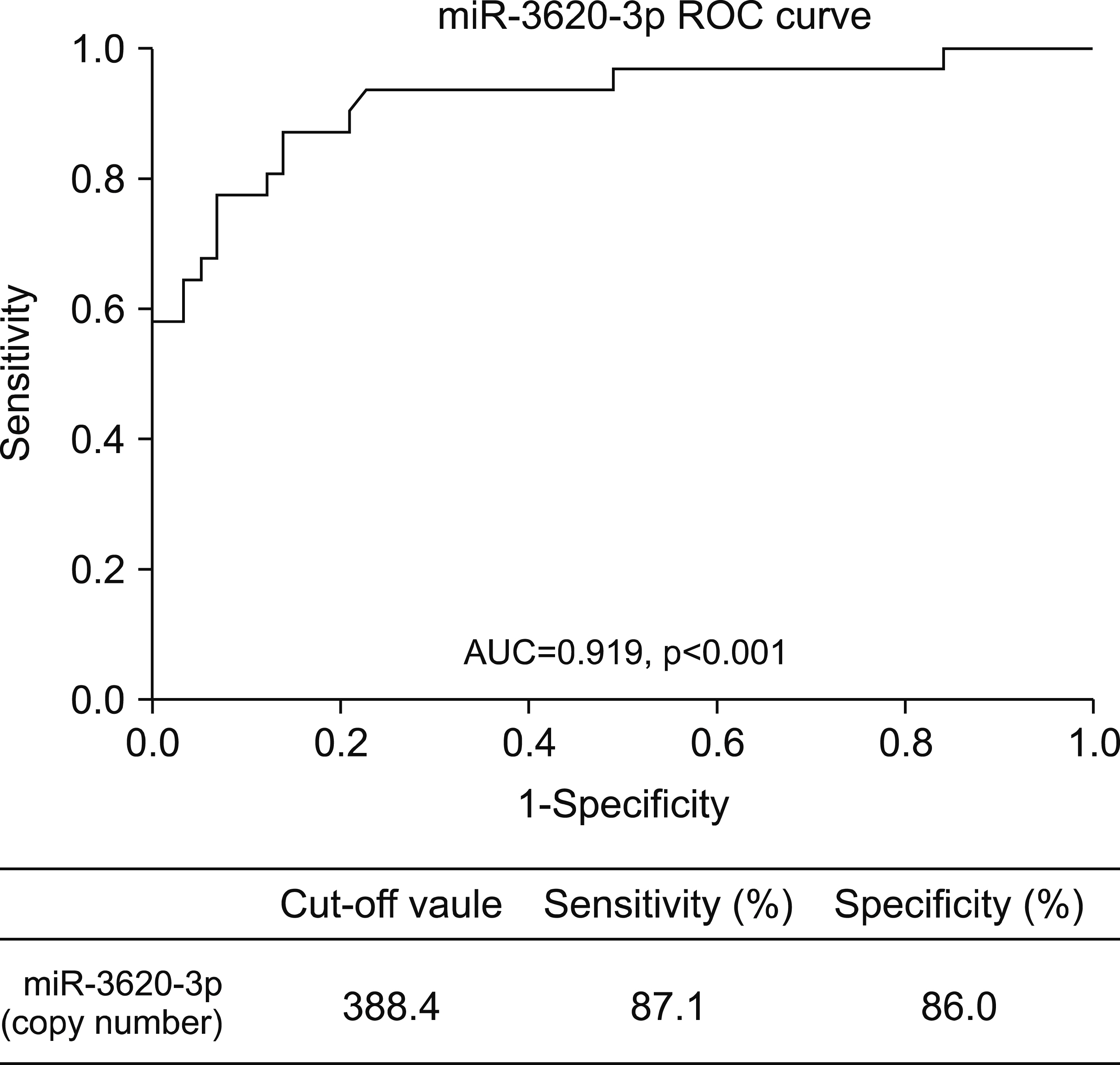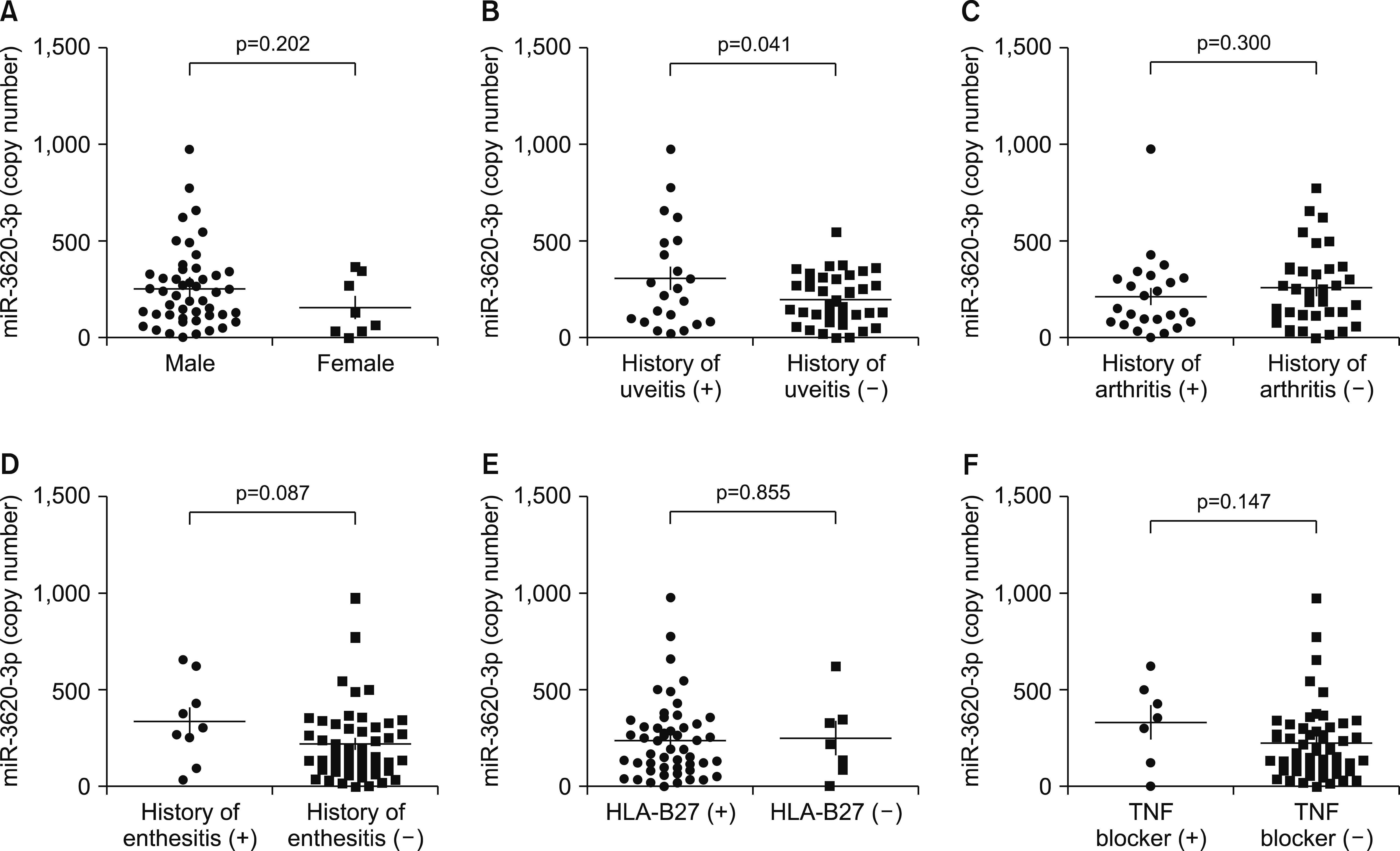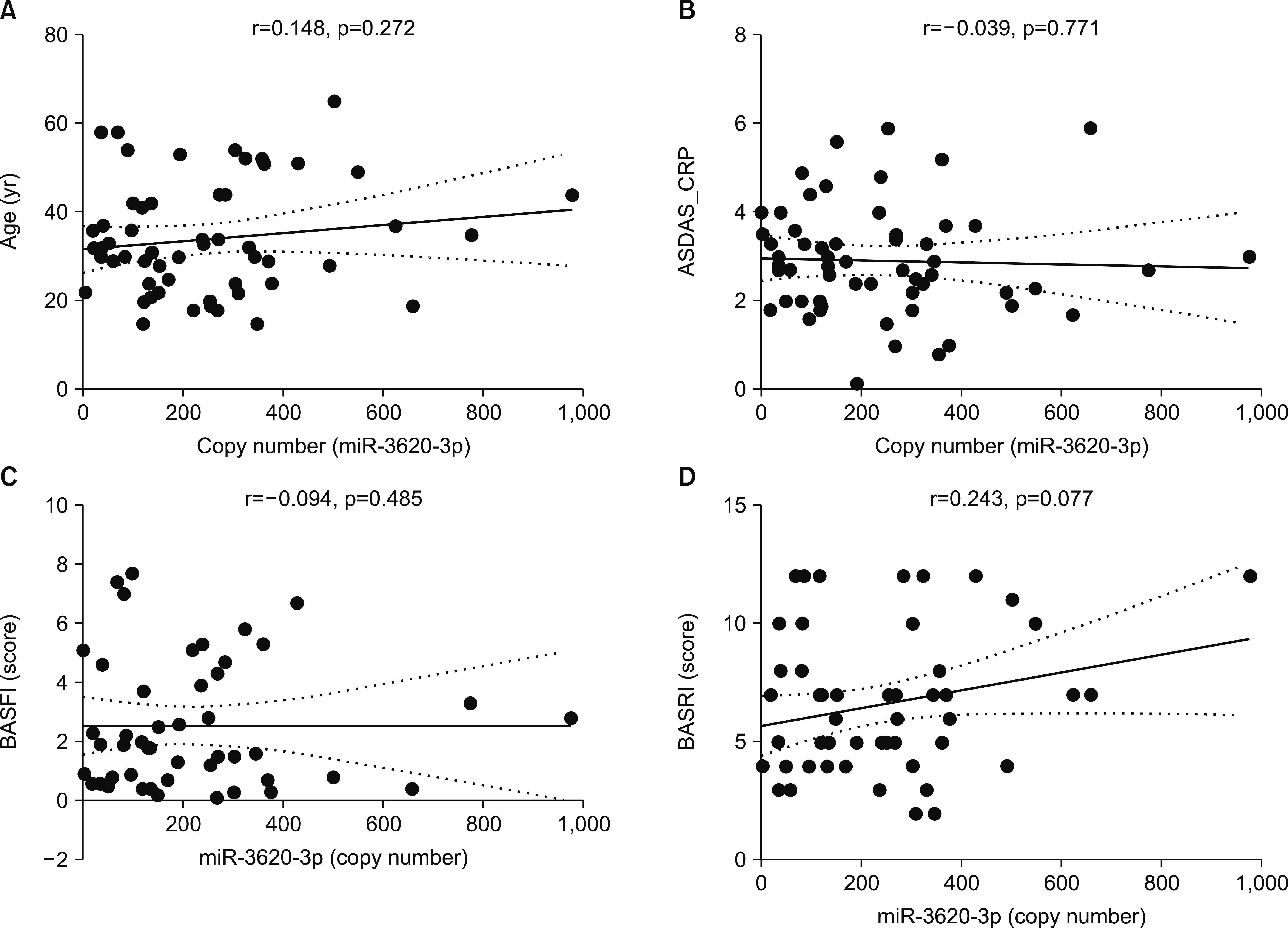J Rheum Dis.
2022 Jan;29(1):33-39. 10.4078/jrd.2022.29.1.33.
Serum miR-3620-3p as a Novel Biomarker for Ankylosing Spondylitis
- Affiliations
-
- 1Department of Rheumatology, Chonnam National University Medical School and Hospital, Gwangju, Korea
- KMID: 2523457
- DOI: http://doi.org/10.4078/jrd.2022.29.1.33
Abstract
Objective
Using microRNA (miR) as a biomarker has been a new way for diagnosing many diseases. Although many studies on miR-biomarker have been published, researches on miR-biomarker in ankylosing spondylitis (AS) are limited. Therefore, the objective of this study was to valiate a candidate serum miR as a novel disease-specific novel miR for AS.
Methods
Total RNAs were extracted from sera samples of patients with AS (n=57), patients with rheumatoid arthritis (RA) (n=37), or healthy controls (HC) (n=19). Through serum miR screening by microarray, differential levels of miR were subsequently validated by real time PCR. At the time of serum sampling, clinical values such as sex, age, disease duration, AS-disease activity score, uveitis, peripheral arthritis, enthesitis, human leukocyte antigen-B27 presence, and recent medication were evaluated.
Results
We found that the expression level of serum miR-3620-3p in AS was notably lower than that in RA or HC. The receiver–operator characteristics curve for determining the diagnostic accuracy showed an area under the curve of 0.919 (p<0.001) with a sensitivity of 87.1% and a specificity of 86.0%. Correlation studies showed that the expression level of miR-3620-3p was only associated with the development of uveitis (p<0.05).
Conclusion
Serum miR-3620-3p can be as a new biomarker for diagnosing AS.
Keyword
Figure
Reference
-
1. Kim TJ, Kim TH. 2010; Clinical spectrum of ankylosing spondylitis in Korea. Joint Bone Spine. 77:235–40. DOI: 10.1016/j.jbspin.2009.11.015. PMID: 20356776.
Article2. van der Heijde D, Sieper J, Maksymowych WP, Dougados M, Burgos-Vargas R, Landewé R, et al. 2011; 2010 Update of the international ASAS recommendations for the use of anti-TNF agents in patients with axial spondyloarthritis. Ann Rheum Dis. 70:905–8. DOI: 10.1136/ard.2011.151563. PMID: 21540200.
Article3. Rudwaleit M, Khan MA, Sieper J. 2005; The challenge of diagnosis and classification in early ankylosing spondylitis: do we need new criteria? Arthritis Rheum. 52:1000–8. DOI: 10.1002/art.20990. PMID: 15818678.
Article4. Bartel DP. 2009; MicroRNAs: target recognition and regulatory functions. Cell. 136:215–33. DOI: 10.1016/j.cell.2009.01.002. PMID: 19167326. PMCID: PMC3794896.
Article5. Chen X, Ba Y, Ma L, Cai X, Yin Y, Wang K, et al. 2008; Characterization of microRNAs in serum: a novel class of biomarkers for diagnosis of cancer and other diseases. Cell Res. 18:997–1006. DOI: 10.1038/cr.2008.282. PMID: 18766170.
Article6. Carlsen AL, Schetter AJ, Nielsen CT, Lood C, Knudsen S, Voss A, et al. 2013; Circulating microRNA expression profiles associated with systemic lupus erythematosus. Arthritis Rheum. 65:1324–34. DOI: 10.1002/art.37890. PMID: 23401079. PMCID: PMC6662589.
Article7. Churov AV, Oleinik EK, Knip M. 2015; MicroRNAs in rheumatoid arthritis: altered expression and diagnostic potential. Autoimmun Rev. 14:1029–37. DOI: 10.1016/j.autrev.2015.07.005. PMID: 26164649.
Article8. Motta F, Carena MC, Selmi C, Vecellio M. 2020; MicroRNAs in ankylosing spondylitis: function, potential and challenges. J Transl Autoimmun. 3:100050. DOI: 10.1016/j.jtauto.2020.100050. PMID: 32743531. PMCID: PMC7388379.
Article9. Chen L, Al-Mossawi MH, Ridley A, Sekine T, Hammitzsch A, de Wit J, et al. 2017; miR-10b-5p is a novel Th17 regulator present in Th17 cells from ankylosing spondylitis. Ann Rheum Dis. 76:620–5. DOI: 10.1136/annrheumdis-2016-210175. PMID: 28039186.
Article10. Lai NS, Yu HC, Chen HC, Yu CL, Huang HB, Lu MC. 2013; Aberrant expression of microRNAs in T cells from patients with ankylosing spondylitis contributes to the immuno-pathogenesis. Clin Exp Immunol. 173:47–57. DOI: 10.1111/cei.12089. PMID: 23607629. PMCID: PMC3694534.
Article11. Kook HY, Jin SH, Park PR, Lee SJ, Shin HJ, Kim TJ. 2019; Serum miR-214 as a novel biomarker for ankylosing spondylitis. Int J Rheum Dis. 22:1196–201. DOI: 10.1111/1756-185X.13475. PMID: 30729703.
Article12. van der Linden S, Valkenburg HA, Cats A. 1984; Evaluation of diagnostic criteria for ankylosing spondylitis. A proposal for modification of the New York criteria. Arthritis Rheum. 27:361–8. DOI: 10.1002/art.1780270401. PMID: 6231933.13. Humphreys JH, Verstappen SM, Hyrich KL, Chipping J, Symmons DP. 2013; 2010 ACR/EULAR classification criteria for rheumatoid arthritis predict increased mortality in patients with early arthritis: results from the Norfolk Arthritis Register. Rheumatology (Oxford). 52:1141–2. DOI: 10.1093/rheumatology/ket113. PMID: 23463807.
Article14. MacKay K, Mack C, Brophy S, Calin A. 1998; The Bath Ankylosing Spondylitis Radiology Index (BASRI): a new, validated approach to disease assessment. Arthritis Rheum. 41:2263–70. DOI: 10.1002/1529-0131(199812)41:12<2263::AID-ART23>3.0.CO;2-I.
Article15. Biomarkers Definitions Working Group. 2001; Biomarkers and surrogate endpoints: preferred definitions and conceptual framework. Clin Pharmacol Ther. 69:89–95. DOI: 10.1067/mcp.2001.113989. PMID: 11240971.16. Mitchell PS, Parkin RK, Kroh EM, Fritz BR, Wyman SK, Pogosova-Agadjanyan EL, et al. 2008; Circulating microRNAs as stable blood-based markers for cancer detection. Proc Natl Acad Sci U S A. 105:10513–8. DOI: 10.1073/pnas.0804549105. PMID: 18663219. PMCID: PMC2492472.
Article17. Li Z, Wong SH, Shen J, Chan MTV, Wu WKK. 2016; The role of microRNAS in ankylosing spondylitis. Medicine (Baltimore). 95:e3325. DOI: 10.1097/MD.0000000000003325. PMID: 27057910. PMCID: PMC4998826.
Article18. Yildirim T, Yesilada E, Eren F, Apaydin H, Gulbay G. 2021; Assessment of plasma microRNA potentials as a non-invasive biomarker in patients with axial spondyloarthropathy. Eur Rev Med Pharmacol Sci. 25:620–5.19. Pockar S, Globocnik Petrovic M, Peterlin B, Vidovic Valentincic N. 2019; MiRNA as biomarker for uveitis - a systematic review of the literature. Gene. 696:162–75. DOI: 10.1016/j.gene.2019.02.004. PMID: 30763668.
Article20. Song YX, Sun JX, Zhao JH, Yang YC, Shi JX, Wu ZH, et al. 2017; Non-coding RNAs participate in the regulatory network of CLDN4 via ceRNA mediated miRNA evasion. Nat Commun. 8:289. DOI: 10.1038/s41467-017-00304-1. PMID: 28819095. PMCID: PMC5561086.
Article21. Popovska-Jankovic K, Noveski P, Jankovic-Velickovic L, Stojnev S, Cukuranovic R, Stefanovic V, et al. 2016; MicroRNA profiling in patients with upper tract urothelial carcinoma associated with Balkan endemic nephropathy. Biomed Res Int. 2016:7450461. DOI: 10.1155/2016/7450461. PMID: 27218105. PMCID: PMC4863087.
Article
- Full Text Links
- Actions
-
Cited
- CITED
-
- Close
- Share
- Similar articles
-
- Serum miR-329-3p as a potential biomarker for poor ovarian response in an in vitro fertilization
- Combined Detection of Serum MiR-221-3p and MiR-122-5p Expression in Diagnosis and Prognosis of Gastric Cancer
- Ankylosing Spondylitis: Prevention And Surgical Correction Of Deformity
- MiR-148a-3p Regulates the Invasion and Odontoblastic Differentiation of Human Dental Pulp Stem Cells via the Wnt1/β-Catenin Pathway
- LncRNA XLOC_006390 facilitates cervical cancer tumorigenesis and metastasis as a ceRNA against miR-331-3p and miR-338-3p





